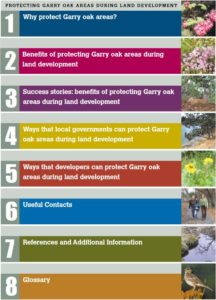Garry Oak Ecosystem Tools
For Government
Municipalities and Regional Districts have many powers to protect Garry oak areas and the species they support during land development.
 This section of the site contains information from the publication “Protecting Garry Oak Areas During Land Development” that GOERT distributed to local governments and developers.
This section of the site contains information from the publication “Protecting Garry Oak Areas During Land Development” that GOERT distributed to local governments and developers.
Protecting and managing Garry oak ecosystems and their species at risk is a challenge to all sectors of society, including local governments, landowners and developers, and consulting land use professionals.
Garry oak areas are some of Canada’s most endangered ecosystems, and include more than just trees. They include woodlands, rock outcrops, wildflower and grassy meadows, coastal bluffs and seasonal pools.
GOERT developed a number of resources to assist local government to protect Garry oak areas and to employ low impact planning and design in and around these landscapes during land development.
Government Policy and Actions
Through inventory, bylaws, incentives and land acquisition, municipal and local government have many options to ensure these areas are protected and managed for future generations.
Identify and map Garry oak areas
Check your bylaws
Provide incentives for conservation on private land
Consider acquiring the land
Work with Developers to Protect Garry Oak Areas
Government can promote and protect Garry Oak areas by sharing information, encouragement and monitoring of development activity, offering alternatives and incentives and ensuring that a plan exists for site during and after construction.
Gather and share information
Encourage protection during land development
Encourage development alternatives
Plan for protection during and after construction
